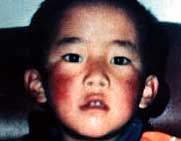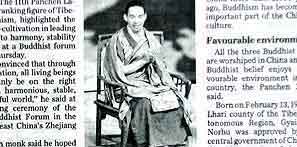Gendhun Choekyi Nyima, the 11th Panchen Lama

Gendhun Choekyi Nyima, the 11th Panchen Lama of Tibet
(Press Release issued by the Amnesty International on January 18, 1996 about the mysterious disappearance of the six-year old Panchen Lama)
Amnesty International is seriously concerned that a six-year old Tibetan boy and his family have been missing from their home for eight months and may be under restriction by the authorities. It is also concerned that Chadrel Rimpoche, abbot of Tashilhunpo monastery and over 50 other monks and laypeople, remain in detention in connection with the disputed choice of the reincarnation of the 10th Panchen Lama, Tibet's second most senior lama.
On 14 May 1995, the Dalai Lama, Tibet's exiled religious leader, announced that six-year old Gendun Choekyi Nyima was the reincarnation of the 10th Panchen Lama. Shortly after this announcement Gendun Choekyi Nyima and his family are reported to have been taken from their home to Beijing and their whereaboutshave been unknown ever since. The Chinese authorities have disputed the Dalai Lama's authority to announce the discovery of the reincarnated Panchen Lama and rejected Gendun Choekyi Nyima in November, chosing instead another six-year old boy, Gyaltsen Norbu, as the 11th Panchen Lama.
Gendun Choekyi Nyima was one of over 20 children discovered by a search committee which was appointed more than six years ago by the Chinese authorities. The leader of this official search committee, Chadrel Rimpoche, the abbot of Tashilhunpo monastery, was detained in May reportedly on suspicion of having communicated with the Dalai Lama about the names of the children.
Meetings were called by the Chinese authorities throughout the summer of 1995 within Tibet's highest religious circles, encouraging them to denounce the Dalai Lama's announcement. In November 1995, religious leaders in Tibet were told by the authorities to prepare written and oral statements criticizing the Dalai Lama and Chadrel Rimpoche.
Chadrel Rimpoche has been removed from his post in July as head of the Tashilhunpo management committee and has been accused of communicating with the Dalai Lama over the choice of the reincarnation. In a speech made on 24 November 1995, the Chairman of the Standing Committee of the Tibet Autonomous Regional Committee of the Chinese People's Political Consultative Conference, criticised the Dalai Lama by name and indirectly criticized Chadrel Rimpoche and others from Tashilhunpo Monastery: "he [the Dalai Lama] arbitrarily announced the so-called reincarnated child of the Panchen in violation of historical convention and the religious rituals of Tibetan Buddhism ... I hope you will set an example by taking the lead in exposing and criticizing the Dalai's crimes of undermining the work related to the reincarnation of the Panchen and in thoroughly exposing and criticizing the crimes of the former responsible persons of the Committee for Democratic Administration at the Tashilhunpo Lamasery who colluded with the Dalai; resolutely negate the so-called reincarnated boy arbitrarily confirmed by the Dalai ..."
In two further official newspaper articles, Chadrel Rimpoche has been criticized by name and accused of the "crimes" of cooperating with the Dalai Lama's alleged attempts to "sabotage" and "violate" the search for the reincarnation of the Panchen Lama. He is accused in some detail of manipulating "religious rituals and the historical convention" to ensure that Gendun Choeyki Nyima was chosen as the reincarnation. Chadrel Rimpoche is also accused of lying about the age of Gendun Choekyi Nyima. On 21 August 1995, a Foreign Ministry spokesman denied that Chadrel Rimpoche was in detention but said that he was ill and in hospital. Amnesty International is concerned at continuing reports from Tibet which indicate that he has been in custody since his detention in May 1995.
The New China News Agency also published a report at the end of November, apparently aimed at discrediting Gendun Choekyi Nyima, saying that the boy had once drowned a dog and calling this a "heinous crime in the eyes of Buddha" which disqualifies him from becoming a leading lama. The report described his parents as "notorious for speculation, deceit and scrambling for fame and profit", adding that they were not "pious, honest and kind people".
In late November 1995, China's Foreign Ministry spokesman, Shen Guofang, said "we have no idea about the whereabouts of the so-called soul boy determined by the Dalai Lama". He denied that Gendun Choekyi Nyima and his family had spent the last few months in detention in Beijing and added that "he is not missing, nor is he incarcerated", but that "he should be wherever he was born". Amnesty International has received reports in January 1996 that the boy and his family are not in their home and have not been seen there since May last year.
Amnesty International remains concerned about over 50 other monks and laypeople detained as a result of the reincarnation controversy. Eight further detentions believed to be associated with the reincarnation dispute have been reported: two lay-women were detained on 2 September 1995 from a carpet factory run by the Tashilhunpo monastery and on 4 November 1995, six monks were arrested for demonstrating outside the monastery.
The current situation of those reported to have been detained since May 1995 is not known, but among those still believed to be held are Chadrel Rimpoche's assistant Champa Chung, Samdrup, a businessman from Shigatse and Gyatrul Rimpoche, a lama from Tashilhunpo monastery. Others who were reported to have been detained include, Shepa Kelsang, Lhakpa Tsering, Ringkar Ngawang, Ngodrup, Tenzin, Tendor, Sherab, Tashi Dondrup, Tsering Phuntsog, Chungdag, Pema, Penpa Tsering, Buchung, Sonam Phuntsok, Tenzin, Gendun, Lobsang Tseten, Wangchuk, Pema Dorje, Lhakpa Tsering, Lobsang Dawa, Tsering Gonpo, Dorje Gyaltsen (all monks from Tashilhunpo) and Sil Zhi and up to 20 other unnamed monks and lay-people.
Please send telegrams/telexes/express and airmail letters in English, Chinese or in your own language, expressing concern that Gendun Choekyi Nyima and his family have not been seen at their home since May 1995 and that it is feared they may be under restriction; calling on the Chinese authorities to disclose their whereabouts and demanding that any restrictions are lifted immediately and that Gendun Choekyi Nyima and his family are free to return to their village and live without restriction or harassment; calling for the immediate and unconditional release of Chadrel Rimpoche, Gyatrul Rimpoche, Champa Chung, Samdrup and over 50 other monks and laypeople who have been detained in connection with the dispute over the 11th Panchen Lama.
Back
The Panchen Lama Controversy

Tibetans refer the Chinese 'appointed' Panchen Lama as 'Panchen Zuma' or 'fake Panchen'.
In 1995 the atheist Chinese government announced the name of a six-year-old child as the new Panchen Lama, despite the fact that His Holiness the Dalai Lama announced the reincarnation of the Panchen Lama, Gendun Choekyi Nyima, a six-year-old boy.
Gyaltsen Norbu, a six year old child from Lhari, in Nagchu, north-eastern Tibet was declared to be the new Panchen Lama. The Chinese ceremony that was held to select the reincarnation of the Panchen Lama not only contradicted His Holiness the Dalai Lama but also defied Tibetan religious tradition.
This violation of religious freedom in Tibet should not be able to stand up in the 1990's. Chadrel Rinpoche, the previous head of the Panchen Lama Search Committee, who was accused of secretly colluding with His Holiness in the proclamation of Gendun Choekyi Nyima as the reincarnation of the Panchen Lama, is still being detained by Chinese authorities.
The safety of Gendun Choekyi Nyima, the six year old reincarnation of the Panchen Lama is now seriously in doubt. The Chinese authorities have denounced the young Panchen Lama and his parents after five months of silence as to their whereabouts. The statement denouncing the boy stated that the boy had 'once drowned a dog' and described his parents as 'notorious for speculation, deceit and scrambling fame and profit', and declared that the family's attempts to 'cheat the Buddha would not be allowed by all ordinary pious Tibetans'.
Back
Panchen Lama Issue: Useful Links
Tibetan Government-in-Exile: Enter
Tashi Lhunpo Monastery: Enter
Where is the Panchen Lama? Enter
Email a Petition to Chinese Authorities: Enter
China Says Vanished Panchen Lama 'Happy' (BBC): Enter
Back
[
articles
|
news-room
|
download
|
films
|
media
|
resources
]

